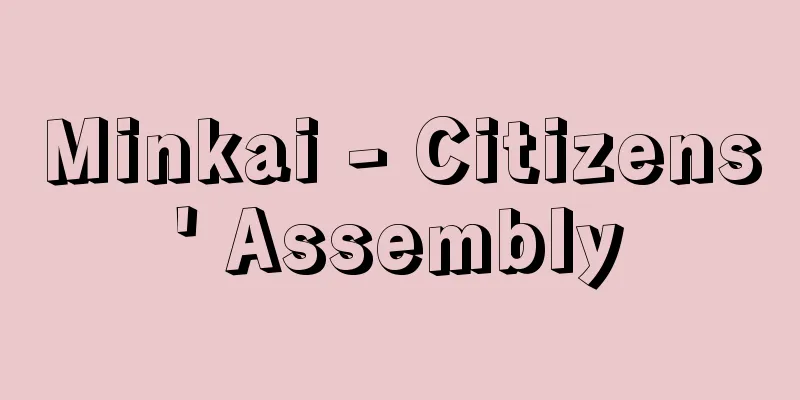Minkai - Citizens' Assembly

|
A general assembly of citizens and other members of a community. Here we will discuss those of classical antiquity and the Old Germanic societies of Europe. [Keiji Baba] AncientIn ancient Greece, the agora (assembly of the people), which could be considered the prototype of the Assembly, was already seen in the heroic epics of Homer, and the king convened the assembly to win the favor of the people and to ascertain the trend of public opinion. There is no reference to the Assembly in the poems of Hesiod, written around 700 BC, but there is no doubt that from the beginning of the establishment of the aristocratic state, the Assembly occupied a position in national politics beyond the framework of the aristocratic class that was in charge of the government, and at the same time had the characteristics of a military assembly. In Athens, the Assembly was called ekklesia (convened assembly) or demos (general assembly of citizens), but in Doric countries it was called apella, halia, or haliaia. The Spartan Assembly became the highest organ of state sovereignty by the legislation of Lycurgus, but the Assembly did not have the right to submit motions, and instead expressed its support or opposition to bills submitted by the Council of Elders, which included the two kings as members. If a bill was rejected, it would either be scrapped or reconsidered by the Council of Elders and resubmitted with an amendment. In Athens, the reforms of Solon in the early 6th century BC established the principle that all citizens, including the lowest class, should attend the Assembly, significantly increasing its importance as a legislative and state organ. However, the power of high officials and the Pagos of Arius, as well as the political influence of noble families, remained strong, and the Assembly was not necessarily independent. The Council of Five Hundred, established by the reforms of Cleisthenes at the end of the same century, presided over the preliminary deliberation of bills to be submitted to the Assembly, and a chairman was selected from among the councilors of the tribe in charge to manage the Assembly. In 462 BC, Ephialtes' reforms were carried out, greatly reducing the powers of the Arius Pagos and high officials that had existed since the aristocratic period, and strengthening those of the Assembly and the People's Court. The Assembly thus became the highest decision-making body in the state in both name and reality, and Athens' so-called thorough democracy was realized. Under the system of the 4th century BC, regular Athenian assemblies were held 40 times a year, and major topics were usually discussed in a set order, but extraordinary assemblies were also convened in response to emergencies. Important decisions required a quorum of 6,000 people, and votes were taken by majority vote. From the end of the 5th century BC, allowances for attendance at the Assembly were also paid. In addition, the civil assemblies of ancient Rome were called comitia (Latin), and there were three types: the Curia, the Centuria, and the Tribe, as well as the Plebeian Assembly.For more information on these, please refer to the entries for "Comitia," "Curia," "Centuria," "Tribe," and "Plebeian Assembly." [Keiji Baba] Old Germanic SocietyThe assembly was called Ding (German) and was a political organization/assembly for making political decisions among the ancient Germanic people. Before the Great Migration, the society of the ancient Germanic people was divided into a great number of small political units called Kiwits, which were equivalent to nations. Although the Kiwits retained a strong communal character, all members of the community, i.e., all adult free people, gathered together to hold the assembly and make political decisions. The assembly performed both political and judicial functions, the main functions of which were to decide on war or peace, to move settlements, to approve succession to the throne (in the case of royal Kiwits), to elect elders (in the case of elder Kiwits), and to amend or change the law (customary law), while the latter was to handle disputes within the community and criminal cases. In that sense, the assembly was also a judicial assembly. Except in emergency cases, the assembly was held regularly (probably once or several times a year, on a new moon or full moon day), and all members attended armed. The coming-of-age ceremony was also held at the assembly. Decisions were made by unanimity, and approval was expressed by clashing shields and spears. During the Great Migration Period, large tribes were formed and political units became larger, so it became difficult to hold assemblies where everyone could gather together, and they lost their political importance. In the Frankish Kingdom, the March or May Military Assembly, convened once a year, retained the remnants of the Germanic Assembly, but the center of political decision-making shifted to the Royal Council, which convened influential people in both spiritual and secular circles, while the function of the judicial assembly was taken over by the regular judicial assemblies (three times a year) held by the count (graf) as he traveled around his jurisdiction, gathering the residents of each region. [Shosuke Hirajo] [References] | | | | |Source: Shogakukan Encyclopedia Nipponica About Encyclopedia Nipponica Information | Legend |
|
市民など共同体の構成員が参加する総会。ここでは古典古代社会とヨーロッパの古ゲルマン社会のものについて述べる。 [馬場恵二] 古代古代ギリシアでは、民会の原型とみなすべき「民の集会(アゴラagora)」はホメロスの英雄叙事詩にすでにみられるが、国王は集会の招集の事実をもって民衆の歓心を買うと同時に民意の動向を確かめる場としていた。紀元前700年ごろのヘシオドスの詩には民会への言及はまったくみられないが、貴族政国家成立の当初から、政権担当者である貴族身分の枠組みを超えた形で民会が国政上の位置を占めていて、同時に軍会の性格をもっていたなどの点は疑えない。民会の名称はアテネではエクレシアekklesia(招集された会)またはデーモスdemos(市民総会)といったが、ドーリス系諸国ではアペラapella、ハリアhaliaまたはハリアイアhaliaiaといった。スパルタの民会が国家主権の最高機関となったのはリクルゴスの立法によるが、その民会には動議提出権はなく、2名の王をメンバーに含む長老会が提出した議案に対して賛否の意思表示を行い、否決された議案は廃案、もしくは長老会で再審議のうえ修正案が再提出されたのであろう。アテネでは、前6世紀初めのソロンの改革によって、最下層の市民を含む全市民の民会出席の原則が打ち出されて、立法・国政機関としての民会の重要性が著しく増大したが、高官やアレイオス・パゴス会議の権限ならびに名門貴族諸家の政治的影響力が依然として強く、民会はかならずしも自立していなかった。同世紀末のクレイステネスの改革で創設された五百人評議会は、民会に提出する議案を予備審議するとともに、当番部族の評議員のなかから議長が選出されて民会運営にあたった。前462年にエフィアルテスの改革が断行されて、貴族政以来のアレイオス・パゴス会議と高官たちの権限が大幅に縮小され、民会と民衆裁判所の権限が強化された。ここに民会は名実ともに国家最高の議決機関となって、アテネのいわゆる徹底民主政が実現した。前4世紀の制度では、アテネの定例民会は年に40回開催され、通常の主要議題が所定の順番で審議されたが、このほか緊急事態に応じて臨時の民会が招集された。重要な決定には6000名の定足数を必要とし、多数決で採決された。前5世紀の末から民会出席手当の支給も行われた。 なお、古代ローマの民会は、コミティアcomitia(ラテン語)とよばれ、クーリア民会、ケントゥリア民会、トリブス民会の3種類および平民会があったが、これらについては、「コミティア」「クーリア」「ケントゥリア」「トリブス」および「平民会」の各項を参照されたい。 [馬場恵二] 古ゲルマン社会民会はディングDing(ドイツ語)とよばれ、古ゲルマン人の政治的意思決定を行うための政治機構=集会であった。民族大移動以前の古ゲルマン人の社会は、いわば国家に相当するキーウィタースとよばれるきわめて多数の小政治単位に分かれていた。キーウィタースは共同体的性格を強く残していたが、共同体の全構成員すなわち成人した自由人の全員が集まって民会を開き、政治的意思決定を行った。民会は政治的機能と同時に司法的機能をも果たし、前者のおもなものは、開戦や講和の決定、定住地の移動、王位の相続の承認(王制キーウィタースの場合)、長老の選出(長老制キーウィタースの場合)、法(慣習法)の修正や変更などで、後者は共同体内部の紛争や刑事事件の処理であった。その点で民会は裁判集会でもあった。緊急の場合を除けば、民会は定期的に(おそらく、年1回ないし数回、新月か満月の日を選んで)行われ、全員が武装して出席した。成人式も民会の席上で行われた。決定は全員一致という形をとり、盾と槍(やり)とを打ち合わせるのが賛成の意思表示であった。 民族大移動期に大部族が形成され、政治単位が大きくなると、全員が集合する形での民会は行われにくくなり、その政治的重要性も失われる。フランク王国では、年一度招集される3月軍会ないし5月軍会がゲルマンの民会の名残(なごり)をとどめていたが、政治的意思決定の重心は聖俗の有力者を招集する王国会議に移り、他方、裁判集会としての機能は、伯(グラーフ)が管轄区域内を巡回しながら、地域ごとの住民を集めて開催する定期裁判集会(年3回)に受け継がれた。 [平城照介] [参照項目] | | | | |出典 小学館 日本大百科全書(ニッポニカ)日本大百科全書(ニッポニカ)について 情報 | 凡例 |
Recommend
Shaku Nihongi - Shaku Nihongi
The oldest surviving comprehensive commentary on ...
Atē (English spelling) Ate
…When people are in the midst of prosperity and t...
Sanbashiki Gorge
This gorge is located in the Kannagawa River in t...
Mardonios; Mardoniya
[raw]? Died 479 BC. A general of the Achaemenid Em...
Antler
…The antlers of North America are very similar to...
pupa exarata (English spelling) pupaexarata
…Pupae with immobile mandibles are called soft-ja...
Cowra Japanese POW camp - Cowra Japanese POW camp
…A city in New South Wales, Australia. Population...
Kushigata [town] - Kushigata
A former town in Nakakoma County in western Yamana...
April Uprising (English spelling)
An 1876 Bulgarian national uprising against Ottoma...
Associated Press
...American news agency. Abbreviation for Associa...
Motivation - motivation
It is a comprehensive concept used when considerin...
OFF-JT
・Off-the-job training - Education and training out...
undertow
…On the other hand, rip currents are difficult to...
Oshima [village] - Oshima
A village in Higashikubiki County in southern Niig...
Coefficient of contraction
...When a fluid leaves a container through its ou...









